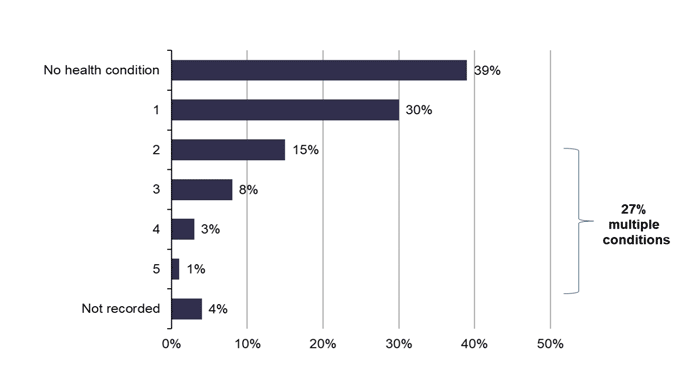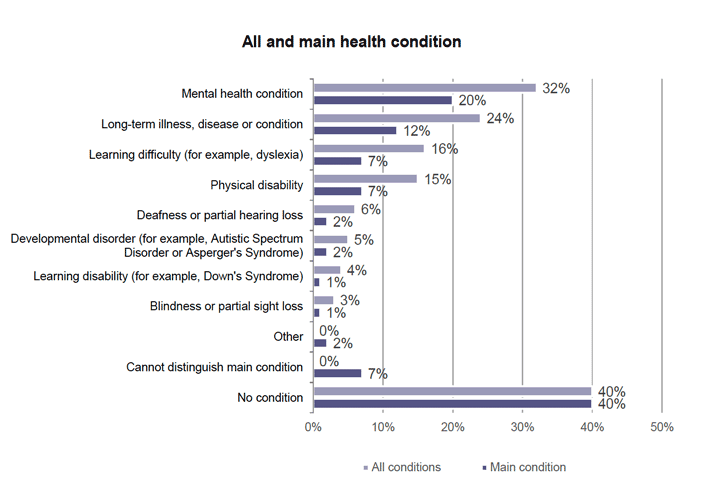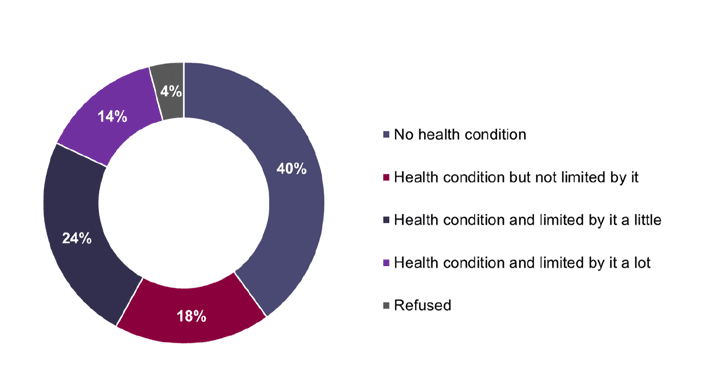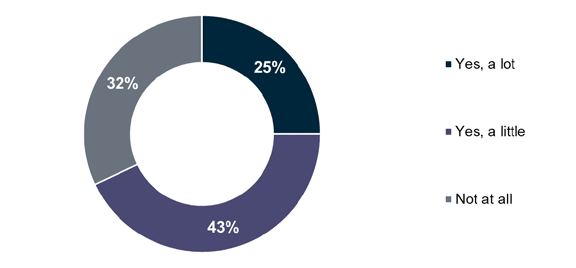Fair Start Scotland: evaluation report 4 - participant phone survey - year 3
Part of a series of reports on the evaluation of Fair Start Scotland (FSS) employability services. The report presents more detailed findings from a representative telephone survey of FSS participants and explores their experiences in the third year of delivery
Health of Respondents
In the 2020 cohort, nearly three in five (57 per cent) participants had at least one long term health condition. As shown in Figure 5, three in ten had one health condition (30 per cent) while three in twenty (15 per cent) had two conditions. Just over a quarter (27 per cent) of the 2020 cohort had more than one health condition. 4 per cent refused to provide this information.

Source: IFF Research telephone survey of FSS customers, Sample information and H4i: Do you have any of the following conditions which have lasted, or are expected to last, at least 12 months? Base: 2020 Cohort (663)
As shown in Figure 6, the most common condition among the 2020 cohort was a mental health condition, with just under a third (32 per cent) of participants reporting this issue. Long-term illnesses were the second most common (24 per cent), followed by a learning difficulty (16 per cent) or a physical disability (15 per cent).
Participants were also asked which of the conditions they reported was their main health condition. Also shown in Figure 6, mental health conditions (20 per cent) and long-term illness (12 per cent) were the most common form of main condition. Two per cent had a condition that was not listed and seven per cent were unable to distinguish which was their main condition.

Source: IFF Research telephone survey of FSS customers, Sample information combined with H4i: Do you have any of the following conditions which have lasted, or are expected to last, at least 12 months? H4m: And which of those would you consider to be your main health condition or disability? Base: 2020 Cohort, except those who refused to provide health condition information(636)
There were some differences between the prevalence of different health conditions amongst participants; the key differences related to age and employment status:
- Age was a key factor affecting both the likelihood of having a health condition as well as the type of condition experienced. While older participants aged 50 and over were most likely to have no health condition (45 per cent), those among this age group with a condition were the most likely to have a long-term illness (36 per cent) or a physical disability (21 per cent), compared younger age groups. In contrast, the youngest age group, 16-24, were the least likely to say they had no condition (34 per cent) and the most likely age group to have a mental health condition (40 per cent) or learning difficulty (26 per cent).
- Another key factor affecting prevalence of health conditions was employment status. This related to employment status reported by participants at the time of the survey. Participants that were in work were more likely to report no long-term health conditions (51 per cent) than those not in work (32 per cent). Moreover, participants who were not working were more likely than those in work to have a mental health condition (37 per cent vs. 28 per cent) or a learning difficulty (19 per cent vs. 11 per cent).
There were smaller but significant differences by geographical location and gender:
- By gender, male participants were more likely to report having a learning difficulty (19 per cent vs. 12 per cent) or learning disability (6 per cent vs. 2 per cent of female participants).
- By geographical location, those in Lot 1 - Glasgow were most likely to have no health conditions (58 per cent) and long-term illnesses were most common among participants from Lot 4 – Forth Valley (35 per cent). This may be due to the age profile of the lots with Glasgow having the lowest proportion of service users over the age of 50 (15 per cent) and Forth Valley having the second highest (33 per cent). Mental health conditions were most commonly reported among Lot 6 – South West (46 per cent).
When comparing the profile of the 2020 cohort with participants who joined the service in 2019 and 2018, a smaller proportion of the 2020 participants had a health condition (57 per cent reporting at least one condition, compared to 64 per cent in 2019 and 74 per cent in 2018). Those that did were less likely to have multiple conditions than the 2019 cohort (27 per cent vs. 37 per cent, respectively), but more likely to do so than the 2018 cohort (16 per cent). The nature of conditions also differed somewhat between the cohorts, for example, the proportion of the 2020 cohort experiencing a long-term health condition (24 per cent) was significantly smaller than in 2019 (31 per cent), but in line with the 2018 cohort (25 per cent).
Impact of health conditions
To gauge the impact that health issues had on FSS participants, all respondents who had a health condition or disability were asked about the extent to which it limited their ability to carry out day-to-day activities, either whether they were not limited by it at all, limited a little or limited a lot. Figure 7 shows the impact of health conditions for all of the 2020 cohort. Around two in five respondents in the 2020 cohort (39 per cent) said they were impacted by a health condition either a little or a lot.

Source: IFF Research telephone survey of FSS customers, H4N_W2. Does your health or disability limit your ability to carry out day-to-day activities? Base: 2020 cohort (663)
Figure 8 shows the impact of health conditions on participants with at least one condition. Just over two thirds (68 per cent) reported their health condition limited them to some extent (either a lot or a little), with a quarter of those with a condition (25 per cent) reporting that it limited them a lot. Just under a third (32 per cent) were not limited by their health conditions.

Source: IFF Research telephone survey of FSS customers, H4N_W3. Does your health or disability limit your ability to carry out day-to-day activities? Base: 2020 cohort with health condition (378)
There were some significant differences between the 2020 cohort and the 2019 and 2018 cohorts, in terms of the impact of their health condition. The proportion limited a little by their health condition was significantly smaller for the 2020 cohort (43 per cent) than in the 2018 cohort (52 per cent), although it was broadly similar to the 2019 cohort (47 per cent). The proportion of each cohort limited a lot by their condition was also broadly similar across the cohorts (25 per cent in 2020 vs. 27 per cent in 2019 vs. 29 per cent in 2018). There was, however, a significantly greater proportion of participants in the 2020 cohort that were not impacted by their condition (32 per cent) than in the 2019 (25 per cent) and 2018 cohort (17 per cent).
Contact
Email: Arfan.iqbal@gov.scot
There is a problem
Thanks for your feedback